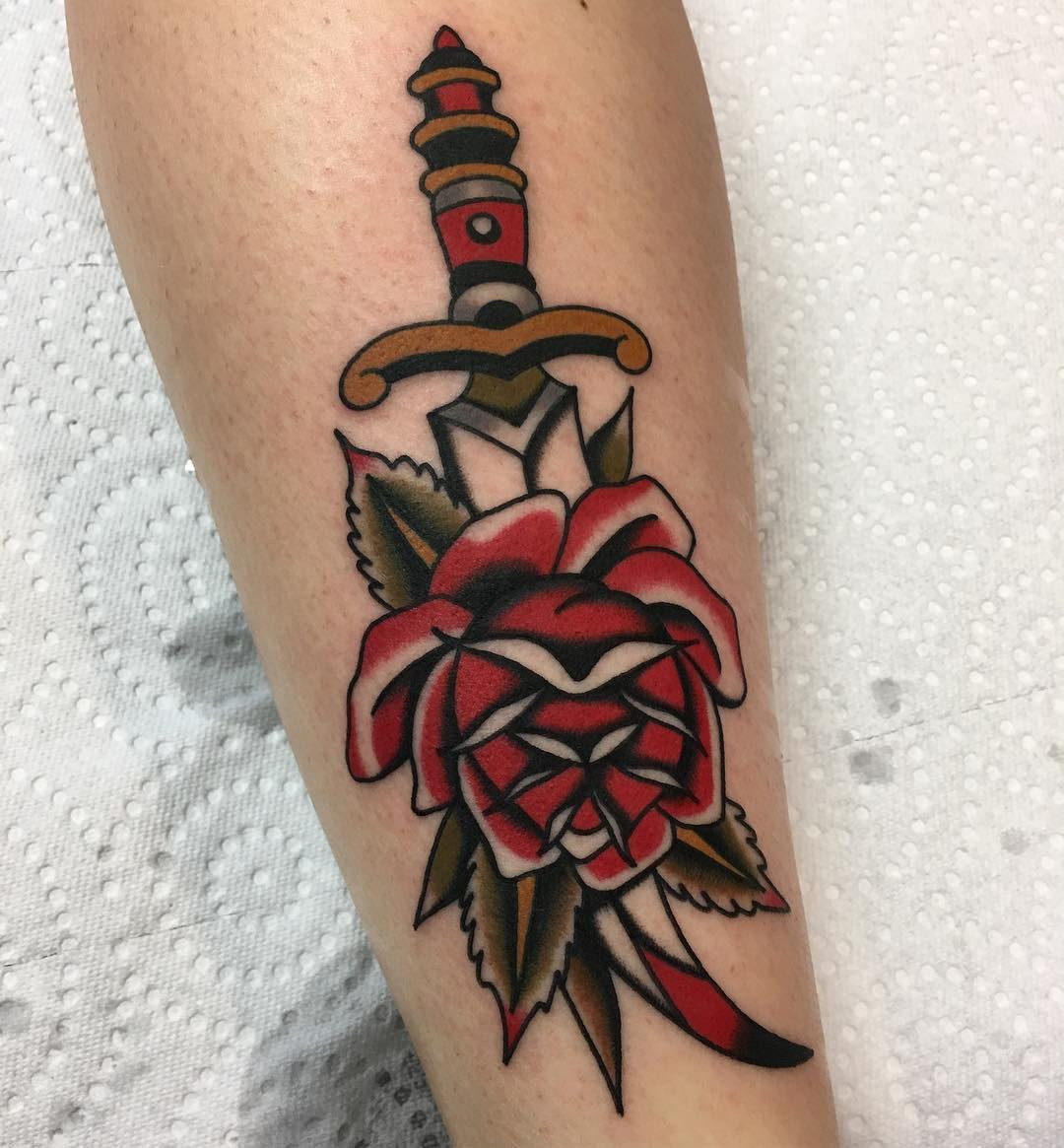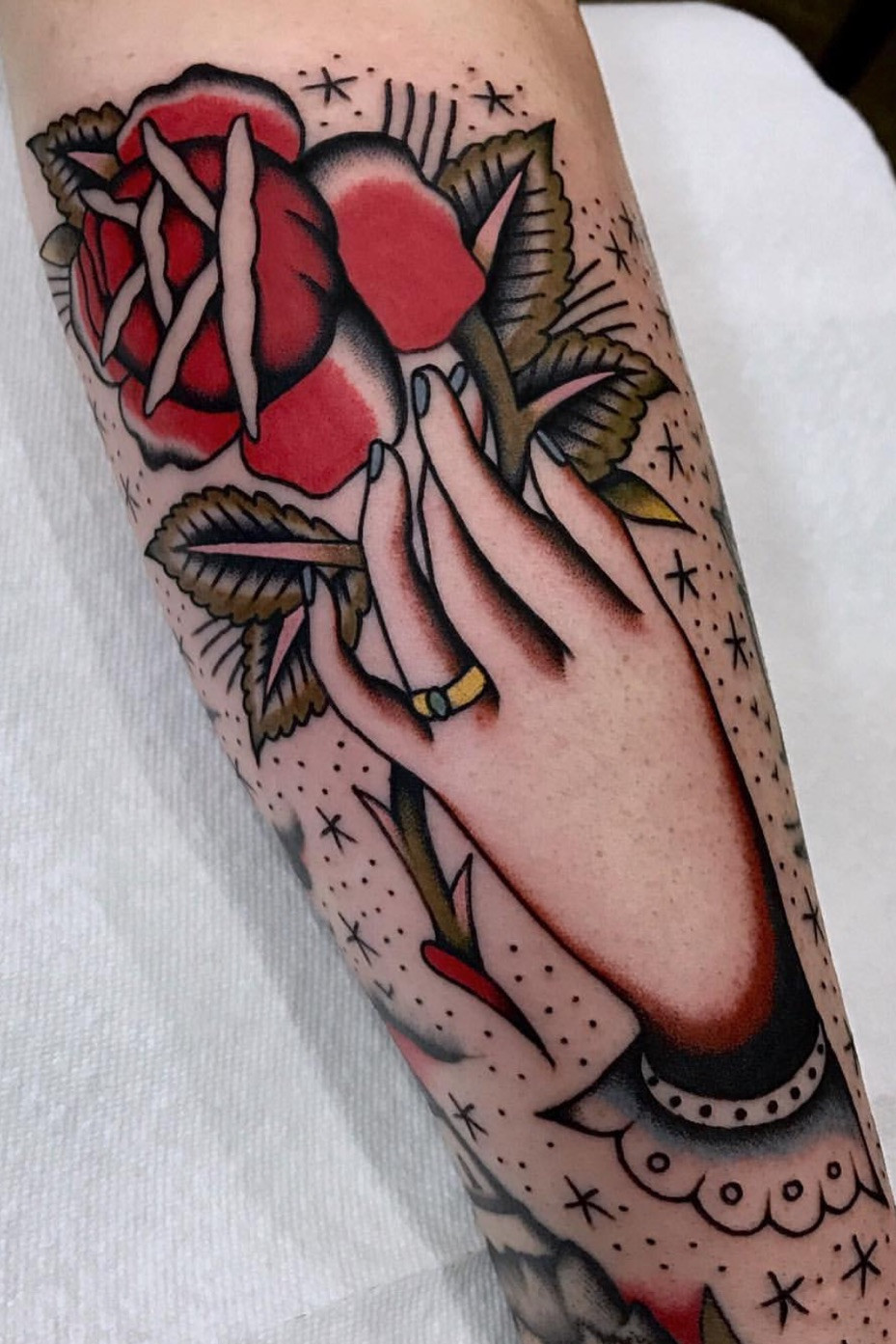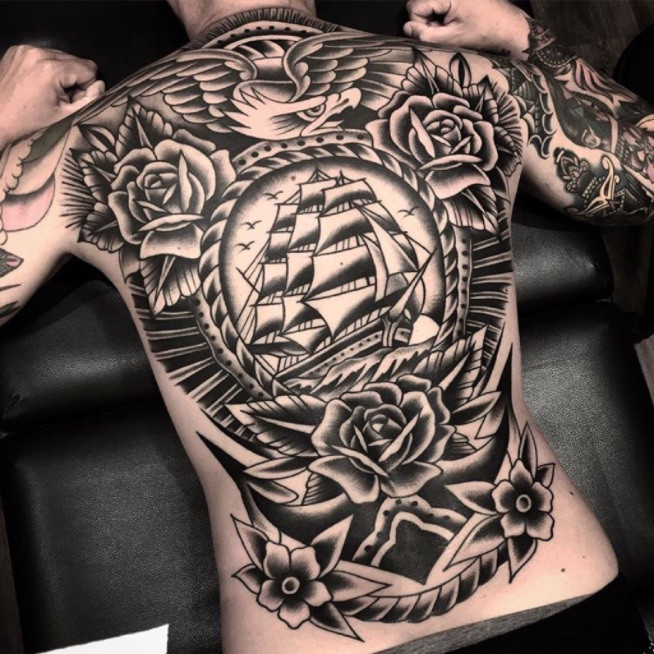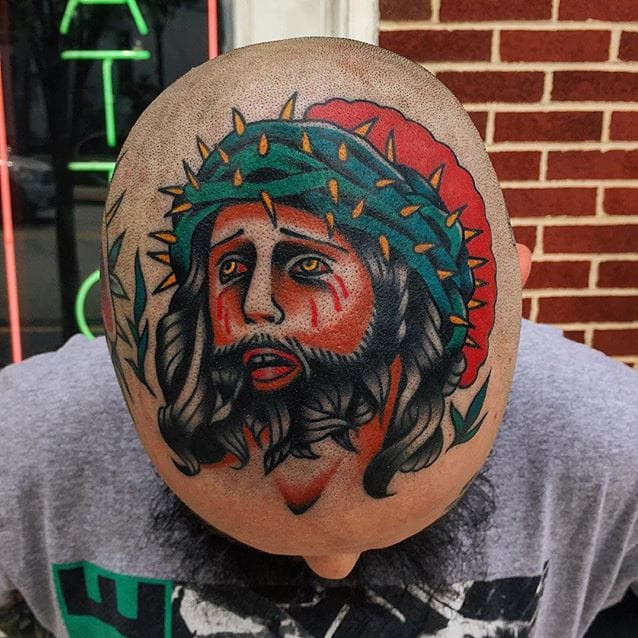What Is A Trad Tattoo? A trad tattoo, also known as American Traditional tattoo, is a distinct style characterized by bold outlines, vibrant colors, and iconic imagery. At tattooat.com, we help you navigate the rich history and artistry of this enduring style, ensuring you find the perfect design and artist to express your unique story. Explore our comprehensive resources for everything related to trad tattoos, from classic motifs to modern interpretations.
1. What Exactly Is a Traditional Tattoo?
A traditional tattoo is a timeless style recognized by its bold black outlines, limited color palettes (typically red, yellow, and green), and classic imagery. This style, rooted in American tattooing history, emphasizes simplicity and longevity. Let’s explore what defines the essence of a traditional tattoo.
- Bold Outlines: Thick black lines are crucial, helping the design hold its shape over time.
- Limited Color Palette: Traditional tattoos usually stick to red, yellow, and green due to the availability of pigments in the early days of tattooing.
- Classic Imagery: Common motifs include roses, anchors, eagles, ships, and pin-up girls.
- Simplicity: Designs are straightforward and easy to read, ensuring they remain recognizable even as they age.
- Durability: The techniques and materials used are chosen to ensure the tattoo lasts for many years with minimal fading.
2. What Are the Origins of Traditional Tattoos?
The origins of traditional tattoos trace back to the late 19th and early 20th centuries, heavily influenced by sailors and soldiers. These individuals brought back artistic ideas from their travels across the globe. According to research from Portland State University’s Art Department, in July 2023, the convergence of cultural exchange and technological advancements led to the unique style we know today as American Traditional.
- Sailor Influence: Sailors, traveling to places like Japan, encountered different tattoo styles and techniques, incorporating them into their own.
- Military Identification: Tattoos served as a form of identification for servicemen in case they died during war.
- Early Tattoo Machines: The invention of the electric tattoo machine by Samuel O’Reilly in 1891 revolutionized the industry, making tattooing faster and more accessible.
- Commercial Flash Sheets: Lew Alberts, also known as Lew the Jew, began selling the first commercial tattoo flash sheets in 1905, standardizing popular designs.
- Unified Aesthetic: The spread of these designs and techniques led to a unified American Traditional style.
3. What Distinguishes a Traditional Tattoo From Other Styles?
A traditional tattoo is set apart by its distinctive features. The bold outlines, limited color palettes, and classic motifs create a unique aesthetic that differs significantly from contemporary styles. Traditional tattoos also stand out due to their historical roots and emphasis on durability.
| Feature | Traditional Tattoo | Modern Tattoo |
|---|---|---|
| Outlines | Bold and black | Fine lines, varied thickness |
| Color Palette | Limited (red, yellow, green, black) | Wide range of colors |
| Imagery | Classic (anchors, roses, eagles) | Diverse, custom designs |
| Style | Simple, easily readable | Complex, detailed |
| Durability | High, designed to last | Varies with technique and ink quality |
| Historical Roots | Strong, tied to early American tattooing | Evolving, incorporates new trends |
4. What Are the Key Elements of Traditional Tattoo Art?
Key elements of traditional tattoo art include bold outlines, a restricted color scheme, iconic images, and a dedication to simplicity and resilience. According to Inked Magazine, these components combine to produce a timeless and visually appealing aesthetic.
- Bold Black Outlines: These create a strong foundation for the design, ensuring it remains defined over time.
- Limited Color Palette: Using primarily red, yellow, and green gives the tattoo a classic, vintage feel.
- Iconic Imagery: Traditional designs like roses, anchors, and eagles are instantly recognizable and carry symbolic meanings.
- Simplicity: The straightforward nature of the designs ensures they are easy to read and age well.
- Durability: Techniques and materials are selected to ensure the tattoo withstands the test of time.
 Traditional tattoo flash featuring a rose and dagger, iconic imagery of the style
Traditional tattoo flash featuring a rose and dagger, iconic imagery of the style
5. What Kind of Imagery Is Common in Traditional Tattoos?
Common imagery in traditional tattoos includes a variety of symbols and motifs, each with its own distinct meaning and historical relevance. These designs reflect the experiences and values of the individuals who first embraced this art form. Here are some of the popular trad tattoo designs:
- Roses: Symbolize love, beauty, and passion.
- Anchors: Represent stability, hope, and security.
- Eagles: Embody freedom, strength, and patriotism.
- Ships: Signify adventure, exploration, and the journey of life.
- Pin-Up Girls: Celebrate beauty, femininity, and nostalgia.
- Hearts: Express love, devotion, and emotion.
- Daggers: Symbolize courage, protection, and overcoming challenges.
- Snakes: Represent transformation, healing, and rebirth.
6. How Have Traditional Tattoos Evolved Over Time?
Traditional tattoos have evolved over time while maintaining their core characteristics. Modern artists often incorporate new techniques and subtle variations while still honoring the original style.
- Preservation of Core Elements: Bold outlines, limited color palettes, and classic imagery remain central.
- Subtle Variations: Artists may introduce slightly different shading techniques or color combinations while staying true to the traditional aesthetic.
- Influence of Modern Techniques: Some artists use modern tattoo machines and inks while maintaining the traditional style.
- Fusion with Other Styles: Occasionally, traditional elements are combined with other styles, such as neo-traditional or illustrative tattooing.
- Continued Popularity: Despite the rise of new tattoo styles, traditional tattoos remain a popular choice, proving their enduring appeal.
7. Who Are Some of the Most Influential Traditional Tattoo Artists?
Many influential traditional tattoo artists have helped shape and popularize the style. These pioneers have left a lasting legacy through their iconic designs and innovative techniques.
- Sailor Jerry (Norman Collins): Known for his nautical themes and vibrant colors.
- Bert Grimm: A legendary figure with a long career and a significant impact on the style.
- Mildred Hull: One of the first prominent female tattoo artists, known for her intricate designs.
- Don Ed Hardy: A modern innovator who brought traditional tattoos to a wider audience.
- Lyle Tuttle: Celebrated for his contributions to the popularization of tattooing.
- Amund Dietzel: Known for his distinctive designs and influence on the early tattoo scene.
- Jonathan Shaw: A contemporary artist who carries on the traditional style with his unique flair.
- Huck Spaulding: Famous for his tattoo machines and contributions to the industry.
- Shanghai Kate Hellenbrand: A respected artist known for her historical knowledge and traditional techniques.
8. Why Are Traditional Tattoos Still Popular Today?
Traditional tattoos remain popular today due to their timeless appeal, durability, and symbolic meanings. Their simple yet striking designs resonate with people of all ages and backgrounds.
- Timeless Aesthetic: The bold lines and classic imagery never go out of style.
- Durability: Traditional tattoos are designed to last, maintaining their appearance for many years.
- Symbolic Meanings: The classic motifs carry rich meanings that resonate with many people.
- Nostalgia: Traditional tattoos evoke a sense of nostalgia for a bygone era.
- Versatility: The designs can be adapted to fit various body parts and personal preferences.
- Easy Recognition: The distinct style is easily recognizable, making it a statement of personal identity.
 Shoulder tattoo featuring traditional elements of a rose and leaves
Shoulder tattoo featuring traditional elements of a rose and leaves
9. How Do You Care for a Traditional Tattoo?
Caring for a traditional tattoo involves following specific aftercare instructions to ensure proper healing and longevity. Proper care helps maintain the tattoo’s vibrant colors and crisp lines.
- Keep the Tattoo Clean: Gently wash the tattoo with mild, fragrance-free soap and warm water.
- Apply a Thin Layer of Ointment: Use a recommended tattoo aftercare ointment to keep the skin moisturized.
- Avoid Sun Exposure: Protect the tattoo from direct sunlight to prevent fading.
- Wear Loose Clothing: Choose clothing that won’t rub or irritate the tattooed area.
- Stay Hydrated: Drink plenty of water to keep your skin hydrated and promote healing.
- Avoid Soaking: Refrain from swimming, taking baths, or using hot tubs until the tattoo is fully healed.
- Don’t Pick or Scratch: Avoid picking or scratching the tattoo to prevent infection and scarring.
10. Where Can You Find a Skilled Traditional Tattoo Artist?
Finding a skilled traditional tattoo artist requires research and careful consideration. Look for artists with a strong portfolio of traditional work and a reputation for quality and professionalism. Tattooat.com offers a curated list of talented artists and studios to help you find the perfect match.
- Online Research: Use websites like tattooat.com to find artists specializing in traditional tattoos.
- Check Portfolios: Review artists’ portfolios to ensure their style aligns with your preferences.
- Read Reviews: Look for reviews and testimonials from previous clients.
- Visit Studios: Visit tattoo studios to assess their cleanliness and professionalism.
- Consultations: Schedule consultations with potential artists to discuss your design ideas and ask questions.
- Ask for Recommendations: Seek recommendations from friends or online communities.
11. What Are Some Modern Interpretations of Traditional Tattoos?
Modern interpretations of traditional tattoos blend classic elements with contemporary techniques and styles. These variations offer a fresh take on a timeless art form.
- Neo-Traditional: This style incorporates finer lines, more detailed shading, and a wider color palette while maintaining the bold outlines and classic imagery.
- Illustrative Traditional: This combines traditional motifs with illustrative elements, creating more complex and artistic designs.
- Blackwork Traditional: This uses only black ink to create bold, graphic designs with a traditional aesthetic.
- Watercolor Traditional: This incorporates watercolor effects into traditional designs, adding a soft, artistic touch.
- Geometric Traditional: This combines traditional imagery with geometric patterns and shapes for a modern twist.
12. How Much Do Traditional Tattoos Typically Cost?
The cost of traditional tattoos varies depending on several factors, including the size, complexity, and location of the tattoo, as well as the artist’s experience and reputation.
- Size and Complexity: Larger and more detailed tattoos will typically cost more.
- Artist’s Experience: Highly experienced and sought-after artists may charge higher rates.
- Studio Location: Tattoo prices can vary depending on the location of the studio.
- Hourly Rate: Many artists charge an hourly rate, which can range from $100 to $300 or more.
- Minimum Charge: Most studios have a minimum charge to cover setup and supplies.
- Custom Designs: Custom designs may cost more than flash designs due to the extra time and effort involved.
13. What Role Did Flash Sheets Play in Traditional Tattooing?
Flash sheets played a crucial role in the development and popularization of traditional tattooing. They provided standardized designs that artists could easily replicate, helping to spread the style and make it more accessible. According to Albert Parry’s book ‘Tattoo: Secrets of a Strange Art’, tattooists relied on flash sheets to keep up with the high demand for new designs.
- Standardized Designs: Flash sheets offered a range of pre-drawn designs that artists could quickly tattoo.
- Accessibility: They made tattooing more accessible to both artists and clients, as designs were readily available.
- Efficiency: Flash sheets allowed artists to work more efficiently, as they didn’t have to create custom designs for every client.
- Popularization: They helped to popularize traditional tattoo motifs, spreading them across different regions and cultures.
- Preservation: Flash sheets preserved classic designs, ensuring they would be passed down through generations of artists.
 Backpiece tattoo featuring black and grey traditional elements by Samuel Briganti
Backpiece tattoo featuring black and grey traditional elements by Samuel Briganti
14. How Do Traditional Tattoos Hold Up Over Time Compared to Other Styles?
Traditional tattoos are known for their longevity and durability compared to other styles. The bold outlines and solid colors help the designs maintain their appearance over many years.
- Bold Outlines: Thick black lines prevent the design from blurring or fading.
- Solid Colors: Solid colors hold up better than intricate shading or fine lines.
- Simple Designs: Simpler designs are less likely to fade or lose their shape over time.
- Ink Quality: Traditional tattoo inks are formulated to last, resisting fading and discoloration.
- Proper Aftercare: Following proper aftercare instructions helps to ensure the tattoo heals correctly and maintains its appearance.
15. What Are the Best Body Placements for Traditional Tattoos?
The best body placements for traditional tattoos are areas that provide a smooth, flat surface and minimal stretching or movement. These placements help to ensure the tattoo heals properly and maintains its appearance over time.
- Upper Arms: A classic placement that provides a smooth, stable surface.
- Forearms: Another popular choice, offering good visibility and minimal distortion.
- Calves: A good option for larger designs, providing a relatively flat surface.
- Thighs: Suitable for larger pieces, offering ample space and minimal stretching.
- Chest: A traditional placement, particularly for bold, symmetrical designs.
- Back: A large, flat surface that allows for intricate and detailed designs.
- Shoulders: A classic choice that provides a smooth, curved surface.
16. How Can You Tell If a Tattoo Artist Is Skilled in Traditional Style?
You can tell if a tattoo artist is skilled in the traditional style by examining their portfolio, reading reviews, and observing their technique. Look for artists who demonstrate a strong understanding of the key elements of traditional tattooing.
- Portfolio Review: Check the artist’s portfolio for examples of traditional tattoos with bold outlines, solid colors, and classic imagery.
- Line Work: Assess the quality of the artist’s line work, looking for clean, consistent lines.
- Color Saturation: Evaluate the color saturation, ensuring the colors are vibrant and evenly applied.
- Design Accuracy: Look for accurate and well-executed traditional designs.
- Reviews and Testimonials: Read reviews from previous clients to gauge the artist’s reputation and skill level.
- Studio Visit: Visit the artist’s studio to observe their workspace and assess their professionalism.
- Consultation: Schedule a consultation to discuss your design ideas and ask questions about their experience and technique.
17. What Is the Significance of Specific Colors in Traditional Tattoos?
The significance of specific colors in traditional tattoos is rooted in their availability and symbolism. The limited color palette of red, yellow, and green each carry distinct meanings and historical relevance.
- Red: Often symbolizes love, passion, and courage.
- Yellow: Represents happiness, optimism, and enlightenment.
- Green: Signifies nature, growth, and harmony.
- Black: Provides the bold outlines that define the traditional style and represents strength and stability.
 Tattoo of Jesus by Alex Zampirri, showcasing traditional style
Tattoo of Jesus by Alex Zampirri, showcasing traditional style
18. How Does the Electric Tattoo Machine Impacted Traditional Tattooing?
The electric tattoo machine, invented by Samuel O’Reilly in 1891, revolutionized traditional tattooing by making the process faster, more efficient, and more accessible. This invention significantly impacted the style and spread of traditional tattoos.
- Increased Speed: The electric machine allowed artists to tattoo more quickly, increasing their productivity.
- Greater Precision: It provided greater control and precision compared to earlier hand-poked methods.
- Wider Availability: The machine made tattooing more accessible to both artists and clients, leading to its widespread adoption.
- Standardization: It facilitated the standardization of tattoo designs and techniques, contributing to the development of the traditional style.
- Innovation: The electric machine spurred further innovation in tattoo technology, leading to the development of more advanced machines and techniques.
19. What Makes Traditional Tattoos a Good Choice for First-Timers?
Traditional tattoos are a good choice for first-timers due to their simple designs, clear lines, and timeless appeal. They offer a straightforward introduction to the world of tattooing.
- Simple Designs: The straightforward designs are easy to understand and appreciate.
- Clear Lines: The bold outlines make the tattoo easy to recognize and maintain over time.
- Timeless Appeal: The classic imagery and style never go out of fashion.
- Durability: Traditional tattoos are designed to last, providing a long-lasting piece of art.
- Lower Risk: The simple techniques and materials reduce the risk of complications or healing issues.
- Easy Aftercare: The straightforward designs are easy to care for during the healing process.
20. Where Can I Learn More About the History of Traditional Tattoos?
You can learn more about the history of traditional tattoos through various resources, including books, documentaries, museums, and online articles. These resources provide valuable insights into the origins, evolution, and cultural significance of traditional tattooing.
- Books: Look for books on the history of tattooing, such as “Tattoo: Secrets of a Strange Art” by Albert Parry.
- Documentaries: Watch documentaries that explore the history and culture of tattooing.
- Museums: Visit museums that feature tattoo exhibits or collections.
- Online Articles: Read articles and blog posts on websites like tattooat.com that delve into the history of traditional tattoos.
- Tattoo Conventions: Attend tattoo conventions to learn from experienced artists and historians.
- Academic Research: Explore academic research and studies on the history and cultural significance of tattooing.
FAQ About Traditional Tattoos
1. Are traditional tattoos only black and red?
No, while black and red are common, traditional tattoos also use yellow and green.
2. How long do traditional tattoos last?
Traditional tattoos are designed to last for many years with minimal fading, thanks to their bold outlines and solid colors.
3. Can traditional tattoos be removed?
Yes, traditional tattoos can be removed with laser tattoo removal, although the process may require multiple sessions.
4. Are traditional tattoos painful?
The level of pain varies depending on the individual and the placement of the tattoo, but most people find traditional tattoos to be manageable.
5. What should I avoid after getting a traditional tattoo?
Avoid sun exposure, soaking the tattoo, and picking or scratching the area to ensure proper healing.
6. How do I choose the right design for a traditional tattoo?
Consider your personal preferences, symbolic meanings, and the overall aesthetic you want to achieve when selecting a design.
7. Can I customize a traditional tattoo design?
Yes, you can work with an artist to customize a traditional design while still maintaining the key elements of the style.
8. What is the difference between traditional and neo-traditional tattoos?
Neo-traditional tattoos incorporate finer lines, more detailed shading, and a wider color palette compared to traditional tattoos.
9. How do I find a reputable tattoo studio for traditional tattoos?
Look for studios with experienced artists, positive reviews, and a clean, professional environment.
10. What are some popular placements for traditional tattoos?
Popular placements include the upper arms, forearms, calves, thighs, chest, back, and shoulders.
Ready to dive into the world of traditional tattoos? Visit tattooat.com for inspiration, artist recommendations, and expert advice. Discover the perfect design and artist to bring your vision to life. Connect with top-rated artists and studios. For personalized assistance, visit us at 1825 SW Broadway, Portland, OR 97201, United States, or call +1 (503) 725-3000. Explore the artistry of traditional tattoos at tattooat.com today!